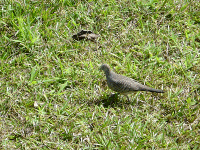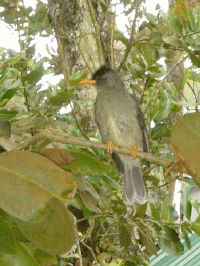|
Birds
This
chapter will be limited to the most remarkable and endemic birds.
The
omnipresent bird is
Acridotheres
tristis or Indian Mynah also
Common Mynah.
Introduced
in the 19th century as a pet, now a real danger for the local fauna
(geckos, chameleons, skinks, frogs caecilians and all sorts of invertebrates),
also feeds on fruits and seeds. His aggressive behaviour towards other birds is
probably one of the main reasons of the decreasing number of magpie robins in
Seychelles.
 People
staying in the hotel will also be taken with the zebra dove Geopelia striata begging
for food at breakfast and lunch. People
staying in the hotel will also be taken with the zebra dove Geopelia striata begging
for food at breakfast and lunch.
Also often seen in the hotel
garden is Foudia
madagascariensis. The Madagascar fody has the size of a small sparrow, is normally
brown, but during the mating season the males get a red head and breast. It is a
very
active bird, prefering open lowlands. There is still some confusion if it is
introduced or not. In 1866 it was recorded for the first time, but was probably
already present when man colonized the islands although in small numbers, and
after the land was cleared for agriculture and housing they increased
sensational. Feeds mainly on seeds (grass), but also begs for rice and bread
crumbs around houses.
Nectarinia
dussumieri the Seychelles sunbird can be seen in the hotel area on
flowering plants
plants .
It is a little bird with a long curved
bill. They resemble, also in their nectar feeding behaviour, the better-known
hummingbirds, but are not at all related. Female sunbirds (left) are quiet plain in
colour, and lack the glittering blue throat gorged of the males (right). They
breed all year round but they lay only one egg. This is probably the only
endemic bird in Seychelles taking advantage from the presence of men, providing
more food by the introduction of flowering plants .
It is a little bird with a long curved
bill. They resemble, also in their nectar feeding behaviour, the better-known
hummingbirds, but are not at all related. Female sunbirds (left) are quiet plain in
colour, and lack the glittering blue throat gorged of the males (right). They
breed all year round but they lay only one egg. This is probably the only
endemic bird in Seychelles taking advantage from the presence of men, providing
more food by the introduction of flowering plants
Hypsipetes
crassirostris or Seychelles bulbul Endemic
 Common
on Silhouette, from the coast to the higher woodlands, prefering the mature forest. It has a particular call, often
imitated by the Indian mynah. Common
on Silhouette, from the coast to the higher woodlands, prefering the mature forest. It has a particular call, often
imitated by the Indian mynah.
Falco
araea or Seychelles kestrel Endemic
(lenght 18-22cm, wingspan 40-45cm)
Endangered
specie, before occurring on all the granite islands, but at the present only on
Mahe(370 pairs), Silhouette(40), and a few on Praslin(10). It is the smallest from all kestrels.
Its diet consists mainly of geckos and skinks 92% of which 65% are phelsumas. he
completes his meal with chameleons, frogs, young birds and insects. The lack of
habitat, but certainly the introduction of cats and rats, reducing their food
supply, is the main reason for the decreasing number of this endemic bird.
Very
rare and in danger of extinction is
 Otus
insularis or the Seychelles scops owl. This very rare owl was presumed to be
extinct from the late 18 hundreds till 1960, when a local naturalist, Phillipe
Loustau-Lalanne, rediscovered this dwarf owl in the mountains of Mahe. Very
little is known about this bird, but its number is decreasing till less than 200
at this moment. Before it occured on most of the higher islands like Mahe
Praslin and Silhouette, but during the last years only seen on Mahe, but also
heard on the 2 other islands in the near past. Otus
insularis or the Seychelles scops owl. This very rare owl was presumed to be
extinct from the late 18 hundreds till 1960, when a local naturalist, Phillipe
Loustau-Lalanne, rediscovered this dwarf owl in the mountains of Mahe. Very
little is known about this bird, but its number is decreasing till less than 200
at this moment. Before it occured on most of the higher islands like Mahe
Praslin and Silhouette, but during the last years only seen on Mahe, but also
heard on the 2 other islands in the near past.
In
the evening, during dinner, it happens that a barn owl Tyto alba flies
through the restaurant of the hotel lodge. It has been introduced in the early
fifties to reduce the rat population, but endemic birds and reptiles were an
easier catch, and the rats were hardly touched. After 10 years realising their
mistake a price from 30 Rupees was put on its head.
Alectroenas
pulcherrima or Seychelles blue pigeon; From time to time this bird can be
seen in the tree-tops of the dead takamaka trees in front of the bungalows from
the hotel lodge. The picturesque Creole name is worth mentioning “pizon olande
sesel”, named after the Dutch flag. Feeds on fruit like the takamaka marbles,
guavas and berries.
Hovering
graceful with their long white tails, high above the mountain rainforest you
have to admire the Phaethon
lepturus or white-tailed tropicbird.

This
tropic bird is a large bird, with a total length from about 80 cm and
a wingspan from nearly one meter. Like all tropicbirds he only comes on
land to breed. He nests in the higher egions of the mountain forest. He mainly feeds on fish and squids, and to catch his pray he
dives from a considerable height.
Psittacula
krammeri or ring-necked parakeet
 Walking
through La Passe you often see a green parakeet. There is only one specimen,
probably imported as a pet but escaped, like there are many in Europe. There are
colonies of 3 to 400 birds in Holland and Germany. It is sometimes confused with
the extinct Psittacula wardi or Seychelles parakeet, extinct on Mahe
since 1866, and the last birds were seen on Silhouette in June 1881. Walking
through La Passe you often see a green parakeet. There is only one specimen,
probably imported as a pet but escaped, like there are many in Europe. There are
colonies of 3 to 400 birds in Holland and Germany. It is sometimes confused with
the extinct Psittacula wardi or Seychelles parakeet, extinct on Mahe
since 1866, and the last birds were seen on Silhouette in June 1881.
 |
